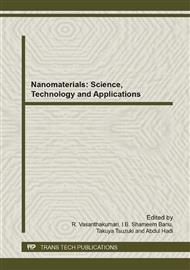[1]
Cobalt in catalysts, The Cobalt Development Institute, 2006, www. thecdi. com/cobaltfacts. php (accessed 28. 02. 13).
Google Scholar
[2]
Cobalt in its alloys, The Cobalt Development Institute, 2006, www. thecdi. com/cobaltfacts. php (accessed 28. 02. 13).
Google Scholar
[3]
D. Kim, D.Y. Park, B.Y. Yoo, P.T.A. Sumodjo and N.V. Myung, Magnetic properties of nanocrystalline iron group thin film alloys electrodeposited from sulfate and chloride baths, Electrochimica Acta 48 (2003) 819-830.
DOI: 10.1016/s0013-4686(02)00773-9
Google Scholar
[4]
G.D. Hibbard, K.T. Aust and U. Erb, Thermal Stability of Electrodeposited Nanocrystalline Ni–Co Alloys, Material Science Engineering 433 (2006) 195–202.
DOI: 10.1016/j.msea.2006.06.096
Google Scholar
[5]
M. K. Roy, V. S. Subrahmanyam, and H. C. Verma, Defect studies in Fe–Cu alloys prepared by electrodeposition, Physics Letter A 328 (2004) 375-379.
DOI: 10.1016/j.physleta.2004.06.015
Google Scholar
[6]
G. Palumbo, U. Erb, J. L. McCrea, G. D. Hibbard, I. Brooks, F. Golzalez, and K. Panagiotopoulous, Proceeding AESF SUR/FIN American Electroplaters and Surface Finishers Society, 2002, p.676.
Google Scholar
[7]
X. Liu, R. Yi, Y. Wang, G. Qiu, N. Zhang, and X. Li, Highly Ordered Snowflakelike Metallic Cobalt Microcrystals, J. Phys. Chem. C 111 (2007) 163-167.
DOI: 10.1021/jp0643597
Google Scholar
[8]
E. Jartych, M. Jalochowski and M. Budzynski, Influence of the electrodeposition parameters on surface morphology and local magnetic properties of thin iron layers, Applied Surface Science, 193 (2002) 210-216.
DOI: 10.1016/s0169-4332(02)00474-9
Google Scholar
[9]
O. Sheveiko, A. Kazakevich, B. Straumal, N. Vershinin and D. Startsev, Modification of metal surface by electroplating and vacuum arc deposition, Frontiers in Corrosion. Science and Technology (2002) 5513–5520.
Google Scholar
[10]
R. T. C. Choo, A. M. EI-Sherik, J. Toguri and U. Erb, Mass transfer and electrocrystallization analyses of nanocrystalline nickel production by pulse plating, J. Appl. Electrochem. 25 (1995) 384.
DOI: 10.1007/bf00249659
Google Scholar
[11]
J.O. M Bockris and G.A. Razumney, Fundamental Aspects of Electrocrystallization, Plenum Press, New York 27 (1967).
Google Scholar
[12]
Y. Liu, L. Liu, Z. Wu, J. Li, B. Shena, W. Hu, Grain growth and grain size effects on the thermal expansion properties of an electrodeposited Fe–Ni invar alloy, Scripta Materiallia 63 (2010) 359-362.
DOI: 10.1016/j.scriptamat.2010.04.006
Google Scholar
[13]
X. Liu et al., Highly Ordered Snowflake like Metallic Cobalt Microcrystal, Journal Physical Chemistry 111 (2006) 163-167.
Google Scholar
[14]
L.P. Zhu et al., Synthesis and Characterization of Novel Three-Dimensional Metallic Co Dendritic Superstructures by a Simple Hydrothermal Reduction Route, Crystal Growth and Design 8 (2008) 1113-1118.
DOI: 10.1021/cg701036k
Google Scholar
[15]
J. O'M. Bockris and A. Damjanovic, The Mechanism of Electrodeposition of Metals in Metals Aspects of Electrochemistry, J. O'M. Bockris and B.E. Conway, Ed. Butterworths, London: Butterworths Publishing 3 (1964) 224-346.
Google Scholar
[16]
C. Suryanarayana and C.C. Koch, Nanocrystalline Materials – Current Research and Future Directions, Hyperfine Interactions 130 (2000) 5-44.
Google Scholar
[17]
N.M. Nik Rozlina, Akram M. Alfantazi, Nanocrystalline cobalt–iron alloy: Synthesis and characterization, Materials Science and Engineering 550 (2012) 388– 394.
DOI: 10.1016/j.msea.2012.04.092
Google Scholar
[18]
K.R. Sriraman, S. Ganesh Sundara Raman, and S.K. Seshadri, S. K, Influence of Crystallite Size on Hardness and Fatigue Life of Steel Samples Coated with Electrodeposited Nanocrystalline Ni-W Al, Material Letters 61 (2007) 715-718.
DOI: 10.1016/j.matlet.2006.05.049
Google Scholar


